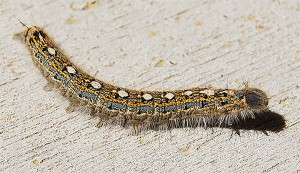
People really hate tent caterpillars. You’ll see folks removing the infected limb or using fire to kill the caterpillars inside. Although tent caterpillars can severely defoliate a tree, they rarely kill it. If you saw the adult fluffy moth, you might feel a bit more empathy for this insect. The moth is reddish-brown with two pale stripes running diagonally across each forewing. Go to the handy dandy Bug guide site at http://bugguide.net/node/view/558/bgimage to see examples of the moth and the caterpillar. By the way, the term caterpillar, besides being a great spelling word, has a pretty convoluted etymology. As best as I could tell from my go-to etymology source, the Online etymology Dictions (http://www.etymonline.com/index.php?term=caterpillar) it comes from the ““mid-15c., catyrpel, probably altered (by association with Middle English piller “plunderer;” see pillage) from Old North French caterpilose “caterpillar” (Old French chatepelose), literally “shaggy cat” (probably in reference to the “wooly-bear” variety), from Late Latin catta pilosa, from catta “cat” (see cat (n.)) + pilosus “hairy, shaggy, covered with hair,” from pilus “hair””. Got it? “Shaggy cat” makes sense, and they often are hairy (those hairs usually are telling you they are poisonous) and in this week’s creature feature, they are plunderers.
The Eastern tent caterpillar (I’ll use the acronym ETC occasionally) oviposit (lay their eggs) almost exclusively on trees in the plant family Rosaceae, with a preference for cherry (Prunus) and apple (Malus) trees. The adult moth lays her eggs in a single batch in late spring or early summer. The egg masses contain on average 200-300 eggs. These masses are covered with a shiny, black varnish-like material and encircle branches that are about pencil-size or smaller in diameter. There is just one generation per year. Embryogenesis (formation and development of the embryo) proceeds rapidly, and within three weeks, fully formed caterpillars can be found within the eggs. But the small caterpillars lie quietly until the following spring, chewing their way through the shells of their eggs just as the buds of the host tree begin to expand.
As soon as they emerge they start to build their tent on the warmest southerly facing part of the tree, usually in a crook between limbs. These caterpillars are extremely light orientated and build their tents (the largest of any tent caterpillar) so that the broadest face of the structure faces the southeast, taking advantage of the morning sun. The caterpillars typically add silk to the structure at the onset of each of their daily activity periods. Silk is added directly to the surface of the tent as the caterpillars walk back and forth over the structure. The silk is laid down under slight tension and it eventually contracts, causing the newly spun layer of silk to separate from the previously spun layer. The tent thus consists of discrete layers separated by gaps within which the caterpillars rest. The tent has openings that allow the caterpillars to enter and exit the structure. Openings are formed where branches jut from the structure but are most common at the apex of the tent.
These are some of the most advanced and social of caterpillars. They build their bags as a way to protect themselves, as a resting place, as a little “glass house” for basking, and as a home base for feeding, not unlike bee hives. This video http://www.youtube.com/watch?v=1qO6eCygcTE of ETCs coming in and out of their tent and expanding it while rapidly defoliating several tree limbs is extremely mesmerizing and also sad if you are a big fan of cherry trees. Since these guys are early spring caterpillars, they have some adaptations to the cooler weather. They can’t digest their food unless they are warm, so they huddle together at night for warmth, bask inside their tents in the day, and will wander about on the outside of the tent, sometimes stretching out and waving their hairs to cool down.
The caterpillars will feed three times a day, in early morning, mid afternoon and in the early evening. Tent caterpillars secrete silk from a spinneret (similar to spiders) wherever they go and their frequently used pathways can be seen by obvious silk trails. As the caterpillars move about the tree, they largely confine their movements to these trails. The silk makes an easy to see their trails, but instead of using touch they use their sense of “smell” (olfactory chemoreceptors) as they follow a pheromone secreted from the posterior tip of their abdomen (insert 6th grade joke here). Caterpillars deposit exploratory trails by dragging the tip of their abdomen as they move over the tree in search of food. Caterpillars that find food and feed overmark the exploratory trails they follow back to the tent, creating recruitment trails. Recruitment trails are much more attractive to the caterpillars than exploratory trails and they serve to lead hungry caterpillars directly to the newest food finds. It is possible for a single successful forager to recruit the entire colony to its food source which is awfully nice of it to do all the work (from http://www.citizendia.org/Eastern_tent_caterpillar retrieved June 2nd, 2013.)
The caterpillars are hairy with areas of blue, white, black and orange. I was enthralled to learn that the blue and white colors you see on an eastern tent caterpillar are structural coloration, not pigments. They use tiny microtubules to fool our eyes into seeing blue and white by selectively filtering light. Many colorful creatures such as peacocks and hummingbirds and butterflies incorporate structural coloration to ward off predators, attract mates, or simply look fabulous with a flexible wardrobe.
Structural coloration was first observed by English scientists Robert Hooke and Isaac Newton, and its principle, wave interference, was explained by Thomas Young a century later. Young correctly described iridescence as the result of interference between reflections from two (or more) surfaces of thin films, combined with refraction as light enters and leaves such films. The geometry then determines that at certain angles, the light reflected from both surfaces adds (interferes constructively), while at other angles, the light subtracts. Different colors therefore appear at different angles. Observing structural coloration and using it in engineering and art is an excellent example of biomimicry, in which people recruit the natural world’s phenomenon for human use. Structural coloration has the potential for industrial, commercial and military application, with biomimetic surfaces that could provide brilliant colors, adaptive camouflage, efficient optical switches and low-reflectance glass (from http://en.wikipedia.org/wiki/Structural_color retrieved June 2, 2013.)
Tent caterpillars, like many other species of social caterpillars, vigorously thrash the anterior part of their bodies when they detect predators and parasitoids. With apologies to “Men Without Hats”, it’s literally a “safety dance”! They may do this either inside or outside of the tent, kind of like a caterpillar dance party. This can be extremely creepy. Such bouts of thrashing, which may be initiated by a single caterpillar (what a ham), radiate rapidly though the colony and may result in group displays involving dozens of caterpillars. Such displays create a moving target for tachinid flies, wasps and other small parasitoids that lay their eggs on or in the body of the caterpillar. They also clearly deter stink bugs and other timid predators. Groups of caterpillars resting on the surface of the tent constitute aposematic displays, which is a fancy way of saying they display warning colors. Few birds other than the cuckoo find the hairy caterpillars palatable. One of the reasons is that they often feed on the leaves of the cherry tree which are cyanogenic (contain a poisonous cyanide compound) and the caterpillars regurgitate cyanide-laden juices when disturbed. Yummy!
After the feeding and dancing and basking, when they are full-grown, larvae leave the host trees and disperse to form loose cocoons in protected places where they pupate. The adult moths (imagos) emerge about two weeks later. They are strictly nocturnal and start flying after nightfall, stopping to hang out and rest a few hours before dawn. Mating and oviposition typically occur on the same day the moths emerge from their cocoons; the females die soon thereafter (sad). If it is any consolation (obviously not for the moth), the Infestations tend to be cyclic in severity, worsening for several years until their populations crash to low levels, then slowly rebuild.
So what about the other two types of creatures that people often confuse with the ETC? Well, entire books have been written about gypsy moths such as Robert J. Spears excellent “The Great Gypsy Moth War: The History of the First Campaign in Massachusetts to Eradicate the Gypsy Moth, 1890-1901”. The gypsy moth was introduced into North America in 1869 from Europe. Professor Étienne Léopold Trouvelot imported the moths, with the intent of interbreeding gypsy moths with silk worms to develop a silkworm industry. Well, of course they escaped. By 1889 they were considered a pest and within 100 years they had spread across the Northeast ( http://www.fs.fed.us/ne/morgantown/4557/gmoth/spread/ retrieved June 2, 2013). Gypsy moths look different from eastern tent caterpillars; the gypsy moth has 5 pairs of blue spots near its head and 6 pairs of red spots from their midpoint to their tail. People also confuse ETC with the common bagworm (Psychidae 1350 species) or the fall webworm (Hyphantria cunea). Fall webworm nests are located at the ends of the branches and their loosely woven webs enclose foliage while the tents of the eastern tent caterpillar do not. They also can be found on both deciduous trees and evergreens such as the Evergreen Bagworm (Thyridopteryx ephemeraeformis). While there may be some overlap, fall webworm generally occurs later in the season (hence the name). In my opinion they are even more disgusting. They are very prolific in my home state of Oklahoma.
And if you are longing for more “bug news”, you are probably aware that the Brood II cicadas are currently munching their way through New York. I wrote about these guys and our local “dog days” cicadas last year (http://yesterdaysisland.com/natures-thermometers-cicadas/) and you may be happy or sad to hear that the 17 year emergence of hordes of cicadas does not occur on Nantucket (or even in Massachusetts this year). This spring to early summer the “coastal” periodical cicada brood called “Brood II” has emerged and will affect the states of Connecticut, Maryland, New Jersey, New York, Virginia, North Carolina and South Carolina.
And in case you are free, get ready for National Moth Week July 20-28th! Citizen scientists around the world (and here on island at the UMass Boston Nantucket Field Station) will be setting up white sheets and lights in backyards, woods and fields for the second annual National Moth Week, a global science project begun last year to encourage the public to observe and document one of nature’s most diverse creatures. Last but not least, to learn more about our local insects, a fascinating description of some of the first insects recorded on Nantucket can be found in “A List of the Insect Fauna of Nantucket, Massachusetts” by Charles Willison Johnson with accompanying “List of Spiders” by James H. Emerton published by the Maria Mitchell Association in July of 1930. You can access a copy at http://www.mariamitchell.org/wp-content/uploads/Publication_Johnson1930_Insects.pdf ).



